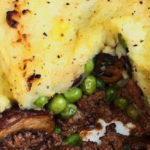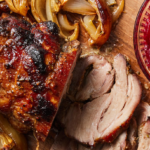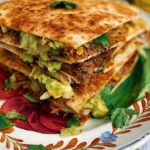
How to Cook Pork
How to Cook Pork the Right Way: Cuts, Marinades, Methods, and Pro Tips

Hey there! I’m Alex, a professional chef based in New York City with over 12 years of experience behind the stove — from fine dining kitchens to casual backyard BBQs. Today, I want to share everything I know about cooking one of the most versatile (and often misunderstood) meats: pork.
If you’re someone who’s always worried about drying it out, or if you’ve only ever tried pork chops that taste like shoe leather — don’t worry, I’ve been there. In this guide, I’ll walk you through the whole process, from choosing the right cut to nailing that juicy, flavorful finish. Whether you’re roasting, grilling, or just pan-frying a quick dinner, by the end of this series, you’ll cook pork with confidence.
How to Choose the Right Cut of Pork
Let’s start with what matters most before you even turn on the stove: the cut of pork you’re working with. Different cuts have different textures, fat levels, and cooking needs — and picking the right one is half the battle. I’ve seen countless dishes fail just because someone tried to pan-fry a pork shoulder or roasted a lean loin without any fat to keep it moist. So here’s how I break it down.

Types of Pork Cuts: Understanding the Difference
Pork Shoulder (aka Boston Butt or Picnic Roast)
This is a flavor-packed, tough cut with a good amount of fat and connective tissue. It’s best for slow cooking, braising, or pulled pork. You don’t want to sear this quickly — it needs time to break down and become melt-in-your-mouth tender.
Pork Loin (not tenderloin!)
The pork loin is leaner, often sold as a roast or in chops. It’s great for roasting in the oven but can easily dry out if overcooked. I recommend using a meat thermometer and removing it from the oven at 145°F (63°C) — it will finish cooking as it rests.
Pork Tenderloin
This is the most tender cut of pork, super lean, and fast-cooking. It’s perfect for searing and then finishing in the oven or slicing into medallions. Since it’s small and lean, it absorbs marinades really well and cooks quickly — 20 minutes tops.
Pork Belly
Rich, fatty, and decadent — pork belly is the cut used for making bacon. It’s perfect for slow roasting or crispy skin recipes like Chinese-style crispy pork.
Pork Neck / Collar (often sold as pork neck or coppa)
This is one of my personal favorites. It’s well-marbled, juicy, and super versatile. You can grill it, roast it, or even braise it. In NYC kitchens, we often slice it thick for pork steaks — amazing on a charcoal grill.
Which Cut Works Best for Each Cooking Method?

For Roasting
- Pork loin (with fat cap still on)
- Pork shoulder (for low and slow)
- Pork belly (for crispy skin and deep flavor)
For Pan-Frying or Grilling
- Pork neck steaks
- Pork chops (bone-in for juicier results)
- Pork tenderloin (marinated)
For Braising or Stewing
- Pork shoulder or butt
- Pork ribs
- Pork cheeks (if you can find them — absolute gold)
How to Recognize Quality Pork at the Store
After choosing the right cut, make sure you’re buying good meat. There’s a world of difference between a sad, pale slab and a fresh, marbled piece of pork. Here’s what to look for:
Color and Texture
Look for meat that’s pink to light red, not pale gray. It should have a firm but not tough texture — when you press it gently, it should spring back. Very dark meat can be older or poorly stored.
Fat Marbling
This is key. Small streaks of white fat running through the meat (especially in cuts like shoulder or neck) mean the meat will be more flavorful and juicy. Don’t be afraid of fat — it’s your best friend in pork cooking.
Smell
Fresh pork should smell clean and neutral, with a slight meaty scent. If it smells sour, musty, or just “off” — walk away. Trust your nose, always.

Prepping Pork Before Cooking
Before you start seasoning or marinating, proper preparation makes all the difference. A good cut won’t reach its full potential if it’s not handled right. So let me walk you through how I do it — from cutting to storage.
How to Cut Pork Properly
The way you slice pork matters. Cut it wrong, and even the most tender piece can turn chewy or dry.
- Cut across the grain: Always. Look at the muscle fibers — they usually run in one direction. Slice against them so the meat is easier to chew. This is especially important for pork shoulder, neck, or chops.
- Even thickness = even cooking: If you’re cutting pork for pan-frying or grilling, aim for even pieces. A half-inch thick cut is perfect for quick cooking, while 1 to 1.5 inches is better for juicy chops.
- Trim before cutting: If your cut has a thick fat cap, you can trim some of it before slicing — but more on that below.
I always recommend using a sharp chef’s knife and a sturdy cutting board. A dull blade will mash the meat instead of slicing it cleanly — and it’s more dangerous for your fingers.
Should You Remove the Fat or Membranes?
Here’s a question I get a lot: should you trim off the fat? The answer depends on how you’re cooking it.

- Leave a thin fat cap for roasting: If you’re roasting pork loin or belly, I like to leave a thin layer of fat. It melts slowly, keeping the meat moist and adding flavor.
- Trim excess fat for frying or grilling: Too much fat can cause flare-ups on the grill or prevent a good sear in the pan. I usually trim to about ¼ inch thick.
- Remove silver skin (the membrane): This is that thin, shiny film on the tenderloin or loin. It doesn’t break down during cooking and makes the meat chewy. Just slide a knife underneath and pull it off — it’s worth the 30 seconds, trust me.
Tips for Storing and Defrosting Pork
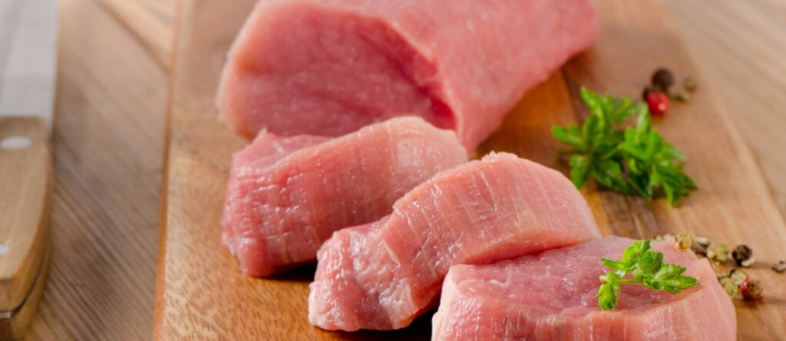
Whether you buy fresh or frozen pork, handling it correctly is essential for safety and flavor.
- Refrigeration: Keep raw pork in the fridge at or below 40°F (4°C). Use it within 3–5 days. I always store it on the lowest shelf, in a covered container, to avoid any cross-contamination.
- Freezing: Pork freezes well. Wrap it tightly in plastic wrap + foil, or use a vacuum sealer if you have one. Label it with the date. It keeps for 4–6 months without losing much quality.
- Defrosting safely: Always defrost pork in the fridge, not on the counter. Depending on the size, this could take 12–24 hours. In a pinch, you can use the cold water method — place the pork in a sealed bag, submerge in cold water, and change the water every 30 minutes.
⚠️ Never refreeze thawed raw pork unless you’ve cooked it first.
Marinades and Spices for Pork
If you want to take your pork dishes from average to impressive, marinating is one of the easiest and most effective steps you can take. It’s not just about flavor — it’s also about texture, moisture, and overall balance.

Why Marinate Pork?
Pork, especially lean cuts like tenderloin or loin, can dry out easily if not handled properly. A good marinade helps prevent that. It softens the fibers, builds flavor from the inside out, and helps the meat retain moisture during cooking. Even fattier cuts like pork shoulder or neck benefit from marinating — especially when grilled, roasted, or pan-fried.
A marinade typically includes three key components:
- An acid (like vinegar or citrus) to tenderize
- Oil to carry flavors and coat the meat
- Spices and aromatics for flavor
It’s a simple formula, but the results are powerful.
Best Marinades for Pork (With Recipes)
Below are four of my favorite go-to marinades — each tried and tested in both home kitchens and restaurants. Each recipe is enough for around 500–700 grams of pork.
Classic Marinade (Onion, Vinegar, Black Pepper)
Great for chops, kebabs, or roast-style pork. The grated onion adds both flavor and natural tenderizing enzymes.
Ingredients:
- 1 large onion, finely grated or chopped
- 3 tablespoons white or apple cider vinegar
- 3 tablespoons vegetable oil
- 1 teaspoon salt
- 1 teaspoon freshly ground black pepper
- Optional: 1 teaspoon paprika for color
Instructions:
- Mix all ingredients thoroughly in a bowl.
- Coat the pork and massage it gently.
- Cover and refrigerate for 3 to 12 hours.
This is a reliable all-purpose marinade with bold, familiar flavors.
Honey-Mustard Marinade
This sweet and tangy mix pairs beautifully with pork loin and tenderloin. It creates a flavorful glaze when cooked.
Ingredients:
- 2 tablespoons Dijon mustard
- 1 tablespoon whole grain mustard
- 2 tablespoons honey
- 2 tablespoons olive oil
- 1 garlic clove, minced
- Salt and pepper to taste
Instructions:
- Whisk everything together until smooth.
- Coat the pork evenly.
- Marinate for 2 to 8 hours.
This marinade is especially good when roasting or pan-searing thicker cuts.
Soy-Garlic Marinade
Perfect for grilled pork or stir-fried slices. Deep, savory, and slightly sweet — with strong umami flavor.
Ingredients:
- 4 tablespoons soy sauce
- 2 tablespoons sesame oil or vegetable oil
- 2 garlic cloves, minced
- 1 tablespoon brown sugar or honey
- Optional: 1 teaspoon grated ginger
Instructions:
- Combine ingredients in a bowl or zip bag.
- Add pork and mix well.
- Marinate for 3 to 6 hours.
Note: No extra salt is needed — the soy sauce handles that part.
Asian-Inspired Ginger Marinade
Great for thinner cuts or pork belly. Inspired by East Asian cooking, this blend adds brightness and heat.
Ingredients:
- 2 tablespoons soy sauce
- 1 tablespoon rice vinegar
- 1 tablespoon honey or mirin
- 1 teaspoon sesame oil
- 1 tablespoon fresh grated ginger
- 1 garlic clove, minced
- Pinch of chili flakes (optional)
Instructions:
- Mix everything together.
- Marinate pork for 1 to 6 hours depending on thickness.
This marinade works especially well for fast cooking on a grill or in a hot skillet.
How Long Should You Marinate Pork?
The marinating time depends on the thickness and the cut:
| Pork Cut | Recommended Marinating Time |
|---|---|
| Thin pork chops or slices | 1 to 2 hours |
| Pork tenderloin | 2 to 4 hours |
| Pork loin roast | 4 to 12 hours |
| Pork shoulder or neck | 6 to 24 hours |
Avoid marinating for more than 48 hours, especially with acidic marinades, as the texture can become too soft or even mushy.
Essential Spices That Pair Well with Pork
If you’re not marinating and just seasoning before cooking, here are the spices I reach for most often. These flavors bring out the best in pork without overpowering it.
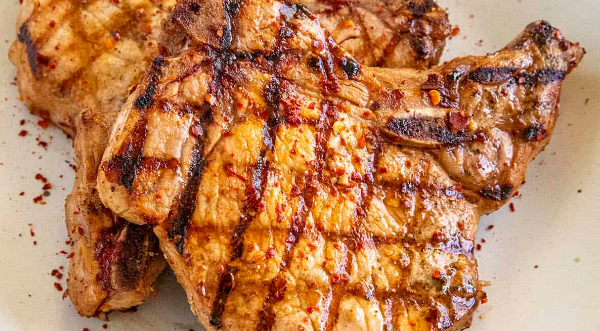
- Black pepper – enhances depth and balances fat
- Garlic (fresh or powdered) – adds warmth and richness
- Paprika (sweet or smoked) – adds color and a mild kick
- Cumin – earthy and warm, great for dry rubs
- Fennel seeds – classic in sausages, good with slow-cooked pork
- Rosemary and thyme – perfect for roasts and oven-baked dishes
- Coriander – light, citrusy, and excellent in both marinades and rubs
- Chili flakes – for a subtle or bold heat
- Bay leaf – adds depth to braises and stews
When I’m short on time, a simple dry rub of salt, black pepper, garlic powder, paprika, and a touch of brown sugar works on just about any cut.
Cooking Methods for Pork
Each cut of pork responds differently to heat. The way you cook it can make it tender and juicy — or turn it dry and tough. That’s why choosing the right method matters just as much as choosing the right cut.
Pan-Frying Pork
Quick, simple, and incredibly satisfying — pan-frying is ideal for thinner cuts like pork chops, medallions, or slices from the shoulder or neck.
How to Get a Perfect Crispy Crust
Getting a golden-brown crust is all about two things: dry surface and hot pan. Here’s what I do:
- Pat the meat dry with a paper towel before cooking. Moisture on the surface will steam the pork instead of searing it.
- Use a heavy pan (cast iron is best) and preheat it until it’s hot — you should hear a strong sizzle when the pork hits the pan.
- Don’t overcrowd the pan. Give the meat space so it browns instead of steams.
- Let it sit. Don’t flip the pork constantly. Let one side brown fully (2–3 minutes), then flip once.
You can finish thicker cuts in the oven after searing for even cooking.
Ideal Temperature Range
Medium-high heat works best. You want the internal temperature to reach 145°F (63°C), then rest for a few minutes off the heat. Use a thermometer if you’re unsure — it makes a huge difference.
Too hot, and you’ll burn the outside before the inside cooks. Too low, and you’ll miss that beautiful sear.
Oven Roasting
Great for large cuts like pork loin, shoulder, or belly. Roasting builds deep flavor and keeps juices locked in when done right.
Temperature and Timing
For pork loin:
- Temperature: Roast at 350°F (175°C) until the internal temp hits 145°F (63°C)
- Timing: Around 20–25 minutes per pound (450–550g), but always go by temperature, not time alone
For shoulder or belly:
- Start with high heat (425°F / 220°C) for 15 minutes to brown the outside
- Then reduce to 300–325°F (150–160°C) and slow-roast for several hours until tender
Let the meat rest 10–15 minutes after cooking before slicing. This redistributes juices and improves texture.
Foil vs. Roasting Bag
- Foil: Helps retain moisture, great for lean roasts. But remove it in the last 15–20 minutes to brown the surface.
- Roasting bag (or sleeve): Locks in juices and aromatics. Excellent for large cuts but doesn’t give much browning.
I often use foil for pork loin and go without it for fatty cuts like shoulder or belly, where a crisp crust is desirable.
Grilling and Charcoal Cooking
Outdoor cooking brings out the best in pork — that smoky flavor just can’t be beat.
Shashlik (Skewered Pork)
A classic method, especially with neck or shoulder cuts. Here’s my usual process:
- Marinate for at least 6 hours in onion, vinegar, oil, and spices.
- Cut pork into chunks about 1.5 inches thick — uniform size ensures even cooking.
- Grill over medium-hot coals, turning occasionally.
- Cooking time is about 12–15 minutes, depending on the heat and size.
The key is not to burn the outside before the inside cooks. Don’t rush. Let the meat gently char and release its fat.
Grilled Pork Steaks
For pork collar or thick chops, grilling gives incredible flavor.
- Season or marinate the meat in advance.
- Grill over medium heat, flipping only once or twice.
- Internal temperature should reach 145°F (63°C) — then rest it off the heat for a few minutes.
I always oil the grill grates and brush the meat with oil to prevent sticking.
Braising (Stewing)
A fantastic way to turn tougher cuts into melt-in-your-mouth meals. Pork shoulder, ribs, or even belly work beautifully here.
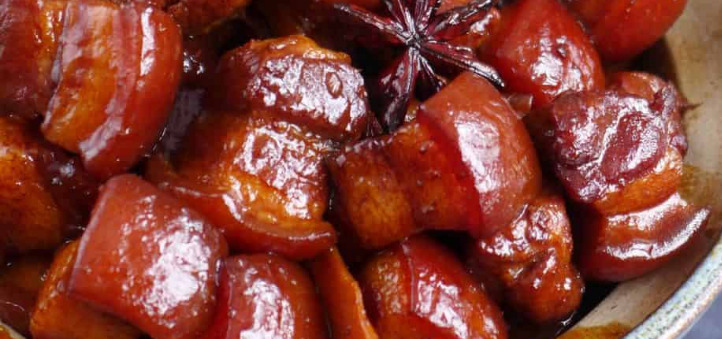
With Onions and Carrots
This is a classic base I use often:
- Brown pork pieces in a pot to build flavor.
- Remove meat, sauté sliced onions and carrots until soft.
- Return pork, add a splash of broth or water, cover and simmer on low for 1.5 to 2 hours.
You’ll get a rich, naturally sweet stew with tender meat and soft vegetables.
With Wine or Beer
Alcohol adds depth and richness. Here’s what I do:
- Brown the meat and aromatics (onions, garlic, celery).
- Deglaze with red wine or dark beer — about 1 cup.
- Add broth or water, herbs (bay leaf, thyme), and simmer for 2–3 hours.
The alcohol cooks off, leaving behind deep flavor. Perfect for colder months.
Slow Cooking and Sous-Vide
If you have the gear, these methods offer unbeatable tenderness and precision.
Slow Cooker (Crockpot)
For pork shoulder or ribs:
- Cook on low for 8 hours or high for 4–5 hours
- Use minimal liquid — pork releases its own juices
- Finish in the oven or broiler to crisp the outside if needed
This method is very forgiving. You can set it in the morning and come home to a ready meal.
Sous-Vide
For pork chops or tenderloin:
- Seal meat in a vacuum bag with seasonings
- Cook in water bath at 140°F (60°C) for 1 to 2 hours
- Sear quickly in a hot pan for color and texture
It’s incredibly precise and delivers perfect results — tender, juicy, never overcooked.
Common Mistakes When Cooking Pork
Even with a great cut and good intentions, pork can go wrong if you overlook a few key details. I’ve seen it happen in restaurant kitchens, at family barbecues, and of course, when I was learning the ropes myself. Here are the most common mistakes — and how to avoid them.

Overcooking the Meat
This is by far the most frequent issue I come across. Pork doesn’t need to be cooked until it’s bone-dry and tough. That old fear of undercooked pork (from the days of trichinosis) still lingers, but modern standards have changed.
The safe internal temperature for pork is 145°F (63°C), followed by a short resting period. At this temperature, the meat is juicy, slightly pink in the center, and perfectly safe to eat.
What I often see:
- People cooking loin or chops to 160°F+ just to “be safe”
- Not using a thermometer and guessing instead
- Forgetting to rest the meat after cooking, which causes juices to escape when slicing
Fix it: Invest in a meat thermometer. It will change the way you cook pork forever.
Incorrect Slicing Techniques
How you cut pork — both before and after cooking — makes a big difference in texture.
What goes wrong:
- Slicing along the grain instead of against it, resulting in tough, stringy meat
- Cutting uneven pieces, especially for pan-frying, which leads to overcooked thin parts and undercooked thick ones
Fix it: Always slice against the grain, especially with shoulder, neck, or loin cuts. Use even thickness for consistent cooking. A sharp knife helps immensely.
Using Too Many Spices
Pork is flavorful on its own. Overspicing can mask the meat’s natural taste or lead to bitter, overpowering flavors — especially if you’re using a marinade with too many strong components (like vinegar, soy sauce, garlic, chili, and sugar all at once).
What I often see:
- Overcomplicated dry rubs with 10+ spices
- Too much salt or strong flavors that clash
- Marinades that don’t balance acidity, sweetness, and fat
Fix it: Keep it simple. Use 2–4 main flavor components that complement each other. Let the meat shine, especially if you’re working with a good cut. Taste your marinade before applying — if it’s unbalanced raw, it won’t get better during cooking.
Not Marinating Long Enough
Marinades need time to work. Rushing this process is like trying to bake a cake in 5 minutes — you’ll miss the transformation.
What I see too often:
- People marinating thick cuts like shoulder for 30 minutes and expecting results
- Skipping marinade entirely for lean cuts like tenderloin
- Using acidic marinades for just 15–20 minutes, which does almost nothing
Fix it: Follow these basic rules:
- Thin slices or pork pieces: 1–2 hours
- Chops or tenderloin: 2–4 hours
- Large roasts or grill cuts: 6–12 hours or overnight
If you’re truly short on time, use a dry rub with salt and spices — it still helps with flavor, even without tenderizing.
Chef’s Tips for Better Pork Every Time
Pork is a forgiving meat, but a few smart techniques can elevate your results from decent to outstanding. These aren’t gimmicks — just small changes that consistently lead to juicier, more flavorful meat.
How to Keep Pork Juicy
One of the most important things I’ve learned over the years is that moisture starts with preparation, not just cooking.
Here’s what works:
- Don’t overcook. As mentioned before, 145°F (63°C) is your magic number for doneness. Any higher and juices start to escape rapidly.
- Use marinades with oil. The fat in the oil helps coat the meat and lock in moisture during cooking.
- Consider brining. For very lean cuts (like loin or tenderloin), soaking in a simple saltwater brine for 1–4 hours before cooking can make a huge difference.
- Cook with the fat on. If your cut has a fat cap, leave some of it during cooking — it melts and bastes the meat from within.
- Use covered or indirect heat for large cuts. Roasting with a lid, foil, or in a bag helps retain internal moisture.
It’s also helpful to monitor the heat during cooking. Too much direct heat can cause the outside to dry out while the inside is still raw.
Why Resting the Meat Matters
Resting cooked pork is non-negotiable in my kitchen.
When pork comes off the heat, its juices are still moving and concentrated near the center due to the cooking process. If you slice it immediately, those juices spill out and leave the meat dry.
Instead:
- Let pork rest uncovered for 5–15 minutes, depending on the cut size.
- For chops or tenderloin: 5–7 minutes
- For roasts: 10–15 minutes
This pause allows the juices to redistribute evenly throughout the meat, making every bite more succulent. I usually tent the meat loosely with foil to keep it warm.
Think of it like letting bread cool before slicing — it holds its shape and flavor better.
Should You Salt Pork in Advance?
The answer is yes — but it depends on timing and the cut.
Here’s how I approach it:
- For chops or steaks (pan-fried or grilled):
- Salt at least 40 minutes ahead, or right before cooking.
- If you salt in that “in-between” window (10–30 minutes), you risk drawing moisture out without giving it time to be reabsorbed.
- For large roasts:
- I salt the night before and let the meat rest in the fridge, uncovered. This acts like a dry brine — the salt penetrates deeply and enhances flavor throughout.
- For marinated meat:
- If the marinade already contains salt (soy sauce, mustard, etc.), there’s no need to salt separately. But if it doesn’t — season lightly before or after.
Salting early helps tenderize and flavor the meat more thoroughly, especially when combined with proper resting.
My Favorite Pork Recipes You Should Try
There are endless ways to cook pork, but over the years I’ve found a few go-to recipes that never fail — whether I’m feeding my family, hosting friends, or working in a professional kitchen. These five recipes aren’t just tasty — they each teach a technique or flavor combo worth mastering.
1. Braised Pork Shoulder with Apple and Cider
This is a fall and winter favorite in my home. The sweetness of apples and the acidity of cider bring balance to the rich pork.
What you need:
- Pork shoulder, cut into large chunks
- Apples (firm varieties like Granny Smith)
- Onion, garlic, dry cider
- Dijon mustard, thyme, salt and pepper
How it’s made:
Sear the pork, then remove it. Sauté onions and garlic, add sliced apples, deglaze with cider, then stir in mustard and herbs. Return pork, cover, and braise at 300°F (150°C) for 2.5–3 hours until fork-tender. The result is rich, tangy, and gently sweet — amazing with mashed potatoes.
2. Pork Schnitzel (Crispy Breaded Cutlets)
A Central European classic — and one of the quickest, crowd-pleasing pork dishes you can make.
What you need:
- Thin pork loin slices or cutlets
- Flour, beaten eggs, breadcrumbs
- Salt, pepper, lemon
How it’s made:
Pound the pork to 1/4 inch thickness. Season with salt and pepper. Dredge in flour, then egg, then breadcrumbs. Fry in shallow oil until golden and crisp on both sides. Serve with lemon wedges and a light salad. Crisp, juicy, and ready in under 30 minutes.
3. Cuban Mojo Pork Roast
This one’s packed with citrus and garlic — bold and unforgettable. Great for tacos, rice bowls, or sandwiches.
What you need:
- Pork shoulder or butt
- Fresh orange juice, lime juice
- Garlic, oregano, cumin, olive oil
How it’s made:
Marinate pork overnight in the citrus-garlic-oil blend. Then roast slowly at 300°F (150°C) for 4–5 hours until fall-apart tender. Shred and toss with the pan juices. I often serve this with black beans, rice, and pickled onions.
4. Spicy Korean Pork Stir-Fry (Jeyuk Bokkeum)
Fast, spicy, and addictive. Great for weeknights when you want something exciting and full of flavor.
What you need:
- Thinly sliced pork shoulder or belly
- Gochujang (Korean chili paste), soy sauce
- Sesame oil, garlic, ginger, sugar
- Green onions, carrots, onions
How it’s made:
Marinate pork in the spicy sauce for 30–60 minutes. Stir-fry over high heat with vegetables until caramelized and glossy. Serve with steamed rice and maybe a fried egg. I keep gochujang on hand just for this dish — it’s that good.
5. Pork and White Bean Stew with Rosemary
Comfort food at its best — hearty, fragrant, and perfect for slow Sundays.
What you need:
- Pork shoulder or ribs (bone-in adds flavor)
- White beans (canned or pre-cooked)
- Carrot, celery, onion, garlic
- Tomato paste, white wine, rosemary
How it’s made:
Brown the pork, sauté the vegetables, stir in tomato paste and wine. Add beans and broth, then simmer until the meat is soft and everything blends together — about 2 hours on the stove or in a slow cooker. Finish with fresh rosemary and cracked black pepper.
Frequently Asked Questions About Cooking Pork
Can I cook pork straight from the fridge, or should I let it come to room temperature?
Always let pork sit at room temperature for 20–30 minutes before cooking, especially larger cuts. This helps it cook more evenly. If you go straight from the fridge to the pan or oven, the outside may overcook before the inside is done.
What’s the best oil for cooking pork?
For high-heat methods like pan-frying or grilling, I use neutral oils with high smoke points — like vegetable, canola, or avocado oil. For roasting or slow cooking, olive oil works well too, since it’s gentler and adds flavor.
Should I wash pork before cooking?
No. Washing raw pork (or any meat) is not necessary and can actually spread bacteria in your kitchen. Pat it dry with paper towels, and that’s all you need.
Is it safe to eat pork that’s still slightly pink inside?
Yes. As long as the internal temperature has reached 145°F (63°C) and the meat has rested, it’s perfectly safe — and much juicier. Slight pinkness doesn’t mean it’s raw.
How do I know when ground pork is fully cooked?
Ground pork should be cooked to 160°F (71°C). It should lose its pink color and have a firm, crumbly texture. Unlike whole cuts, ground meat requires full cooking for safety.
Can I reuse pork marinade for sauce?
Only if you boil it first. Used marinade has raw meat juices, so if you want to turn it into a sauce, bring it to a full boil for 2–3 minutes to make it safe.
How do I reheat cooked pork without drying it out?
Use gentle heat. Cover slices with foil and reheat in the oven at 300°F (150°C), or use a pan with a splash of broth and lid to steam it. Microwaves can dry it out unless you add moisture and cover the dish.
Can I freeze cooked pork?
Yes, absolutely. Let it cool completely, slice or portion it, then wrap tightly and freeze. It will keep for about 2–3 months. For best results, reheat gently with some sauce or broth.
What’s the difference between pork loin and pork tenderloin?
They sound similar but are very different cuts. Pork loin is wider, leaner, and better for roasting. Tenderloin is smaller, thinner, more tender, and cooks much faster. Don’t confuse them — they’re not interchangeable.
How do I prevent pork chops from curling in the pan?
Make small cuts through the fat strip along the edge of the chop (every 1–2 inches). This keeps the fat from tightening and warping the meat during cooking.
What can I do if pork comes out too salty?
If the pork is already cooked, serve it with plain sides (like rice or potatoes) to balance the salt. For stews, you can add unsalted broth, cooked beans, or vegetables to dilute the saltiness.
Is it better to cook pork with or without the bone?
Bone-in pork often cooks more evenly and retains more flavor, especially in chops or roasts. It also looks better for presentation. Boneless is faster and easier to portion but can dry out more easily.
How can I tell if pork is spoiled?
Trust your senses:
- Smell: sour, ammonia-like, or off smells mean it’s gone bad.
- Color: green or gray spots are a red flag.
- Texture: sticky or slimy surfaces usually mean spoilage.
Always err on the side of caution.
Can I sous-vide pork without a vacuum sealer?
Yes. You can use the water displacement method with a zip-top freezer bag. Submerge the bag slowly into a pot of water to push the air out before sealing. Just make sure the bag is heat-safe and fully closed.
What herbs pair best with pork in different styles of cooking?
Here’s how I use herbs with pork:
- Roasts: rosemary, thyme, sage
- Asian dishes: cilantro, green onion, Thai basil
- Grilled pork: oregano, parsley, chili flakes
- Braised pork: bay leaves, marjoram, fennel
- Sweet glazes: mint or a touch of cinnamon (especially with fruit-based sauces)
Don’t overdo it — herbs should enhance, not overpower.
